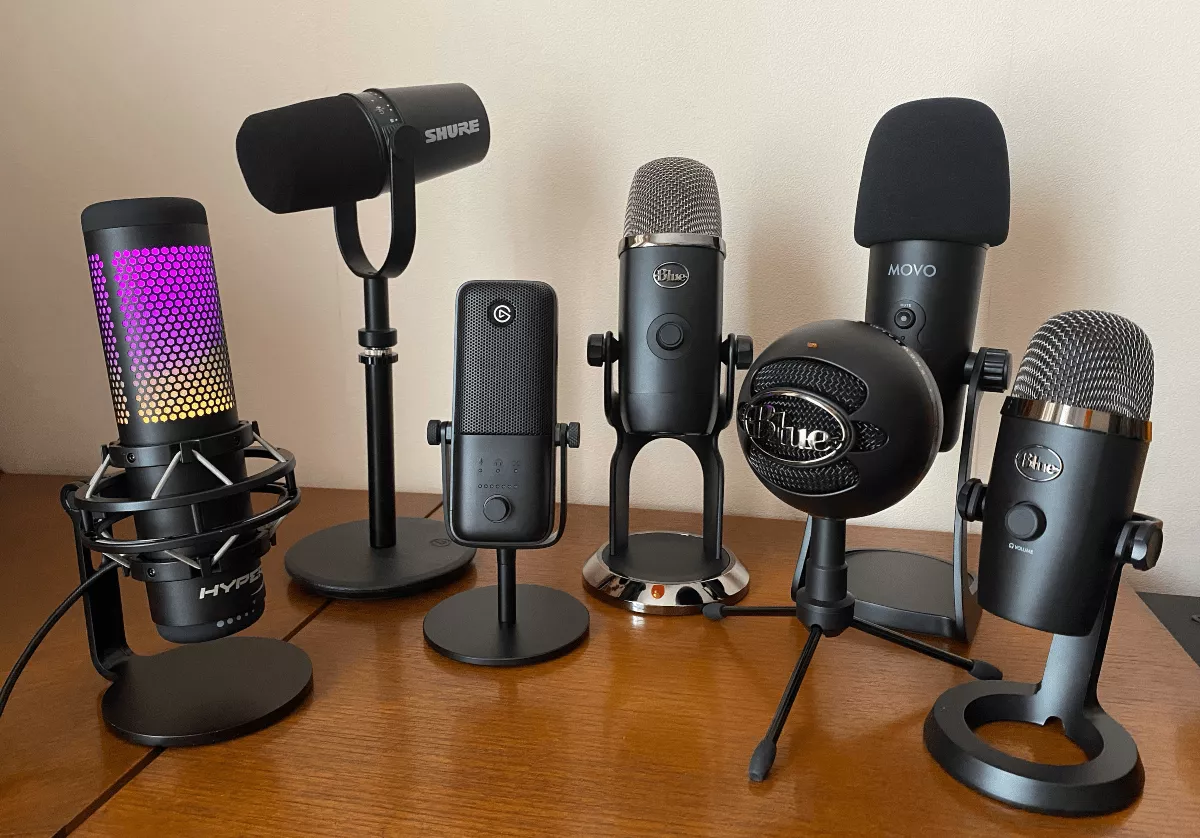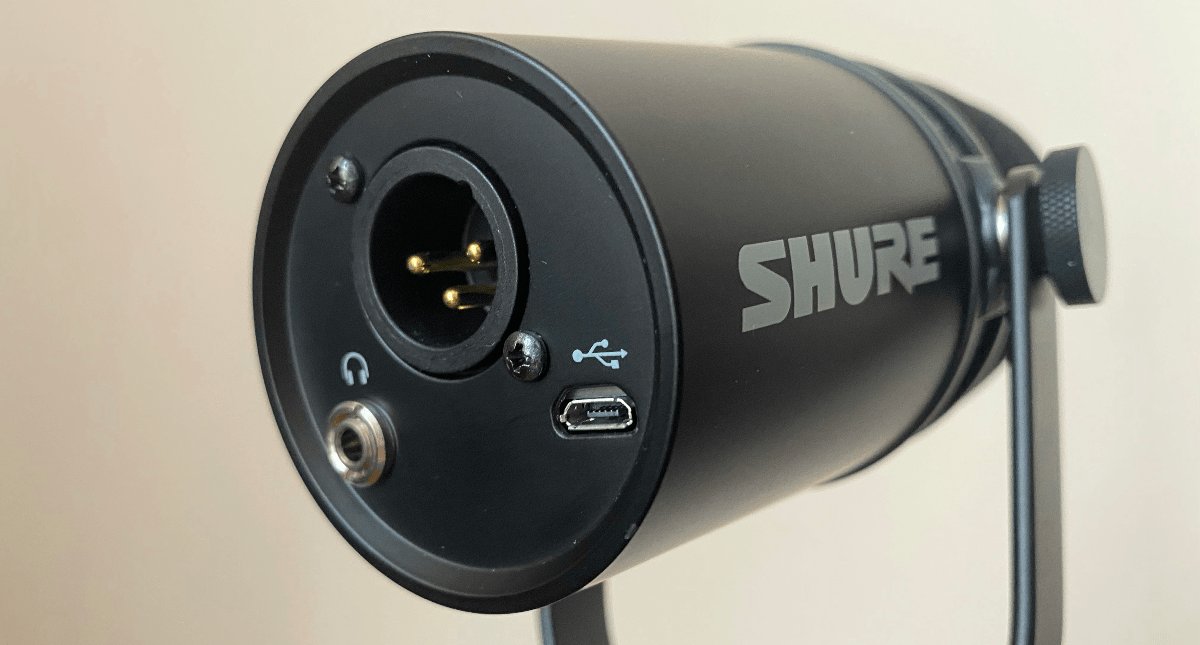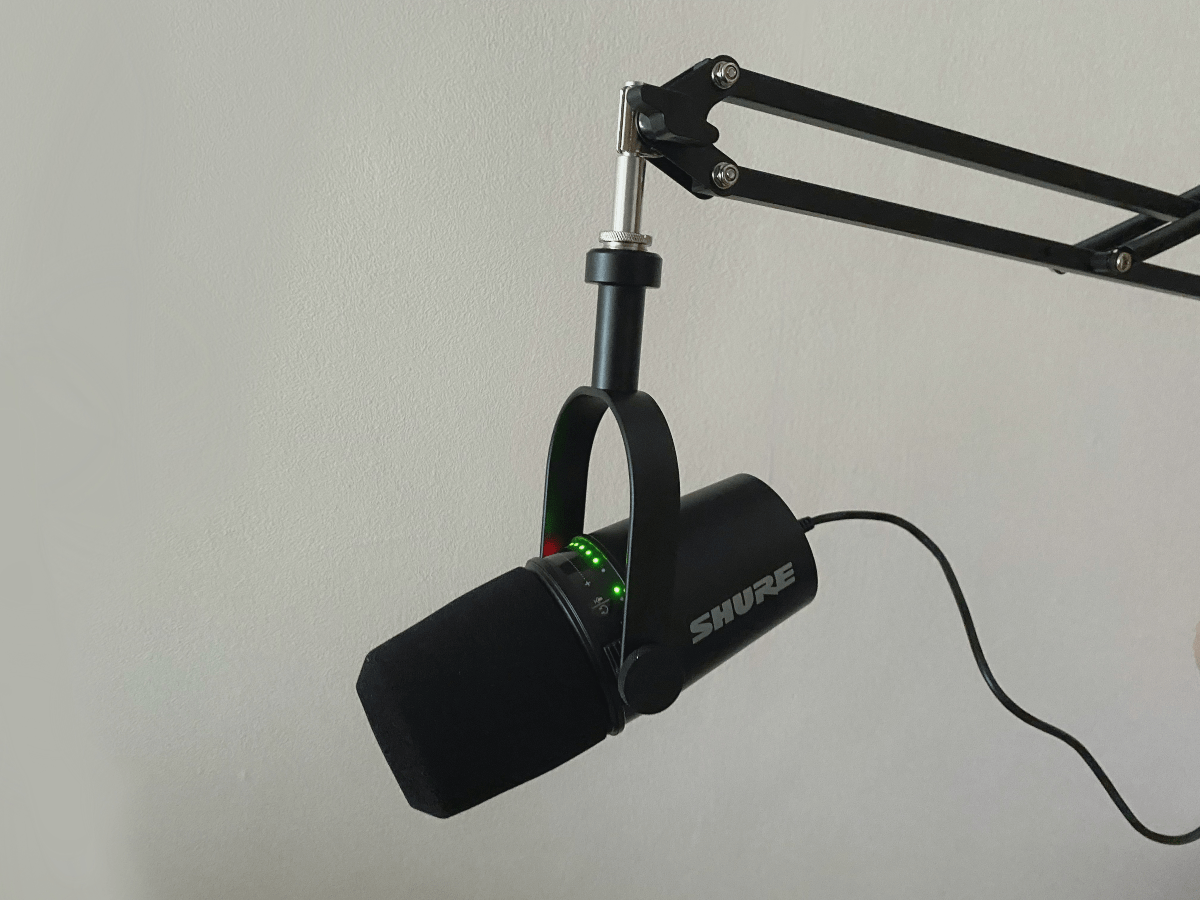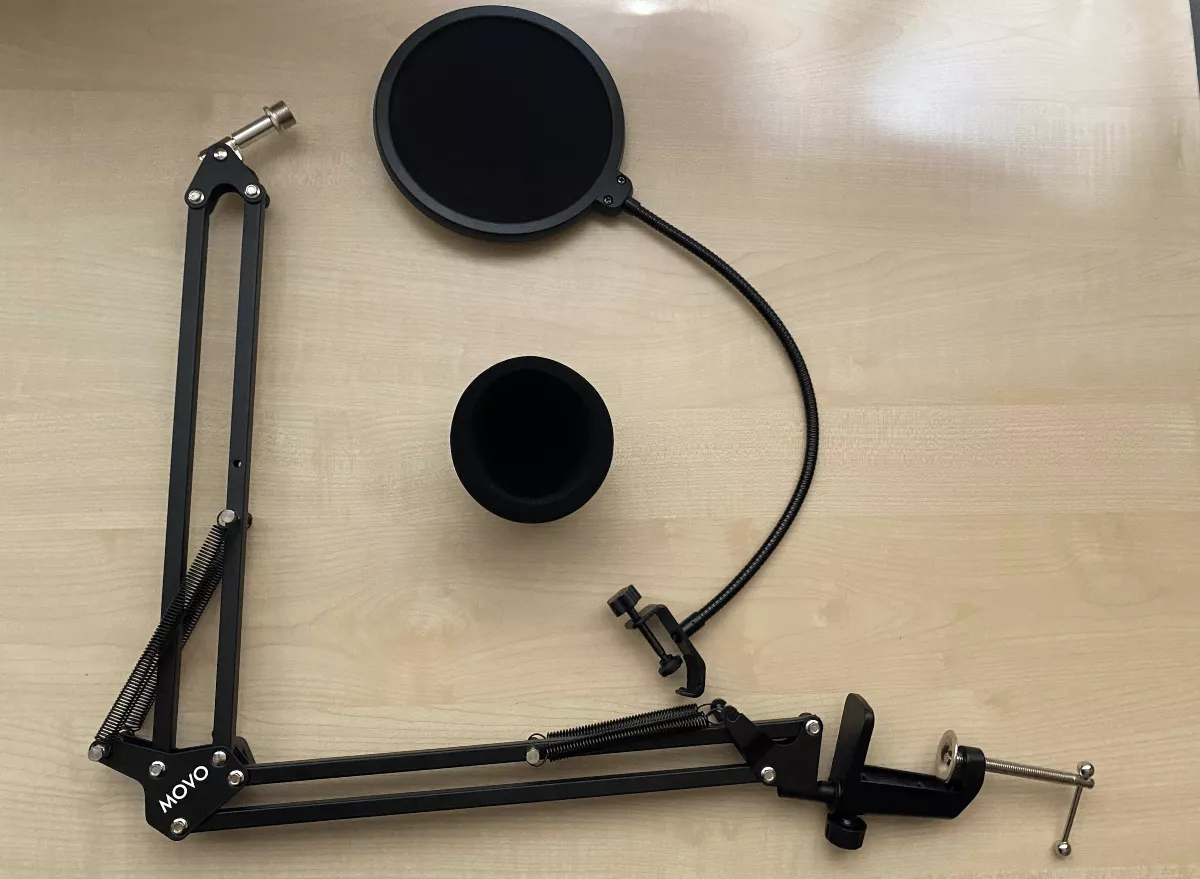The best USB microphones deliver crisp vocal clarity, versatility, ease of use and affordability. Here are the best 7 for most users, and for a range of budgets.
Our favorite microphone for streaming and general use has got to be the Blue Yeti X. It’s an outstanding mic that balances value for money with crisp sound quality, making it perfect for anyone looking to upgrade their audio game.
That said – there are plenty of amazing mics on the market and we have full confidence in the 7 models featured below. They’re great for general use, but will be especially useful for podcasters, streamers, content creators and remote workers.

Our team has extensively tested all microphones below to form our opinions. We’ve also explained some important concepts at the bottom to help any newcomers make sense of the wonderful world of mics.
We’ve chosen to focus on USB mics for a reason. Die-hard audiophiles may snub USB mics, but we think they’re ideal for most people since you don’t need to purchase extra studio equipment to use them. That said, some mics below also offer the additional option of XLR output.
Note
Prices shown in this article were based on the time of writing. To view current prices, click on the various product links.
Blue are the whizzes of the USB mic world, with 25+ years of experience in audio. Their Blue Yeti range has long been the default pick of streamers, but we’re putting their Yeti X mic in the top spot. Released in 2019, the Yeti X is their most full-featured yet and offers an impressive blend of versatility and quality for its price.
Not only does it record remarkably good audio, but the Yeti X can record a total of 4 pick-up patterns. This makes it flexible enough for a huge range of projects. Whether you’re making a podcast, in a group conference call, streaming on Twitch, interviewing someone across a table, or recording a jamming session – having one Blue Yeti X eliminates the need to purchase multiple mics.
It’s design is also sleek; it both feels premium and looks professional on camera. The on-mic controls and features provide quick access to important features. One example is the 11-dot LED meter that displays audio levels, so you can tell at a glance if someone is speaking too loud and quickly turn down mic gain so your audio doesn’t get clipped.
The mic gets even better when paired with Blue’s free VO!CE software – which has enough features to keep both audio-engineers and beginners happy. You can easily activate their finely-tuned presets to do things like reduce unwanted noise or tune your voice to sound richer and more professional. Users who are more audio-savvy can also create their own audio-profiles. All this saves time and money spent on post-processing or third-party plug-ins.
In all, if you want a microphone for streaming and home recording, the Yeti X is excellent. It doesn’t quite give you studio quality recording, but it’s fairly close and is much more affordable. We love it!
| Specifications | Descriptions |
|---|---|
| Mic type | USB condenser mic |
| Dimensions (H x W x L, in) | 11.38 x 4.8 x 4.33 (with Mount) |
| Weight (lbs) | 2.8 |
| Power source | Corded Electric |
| Pick-up patterns | 4 – stereo, cardioid, omnidirectional and bidirectional |
| Sample / Bit Rate | 48 kHz, 24-bit |
| Starting price | $182.99 (see on Amazon) |
Elgato is a popular brand with streamers, so it makes sense that the Elgato Wave 3 targets this demographic. Whilst there’s a lot to love about this sleek looking mic, there are two unusual features that make it outstanding.
The first is their very impressive ClipGuard – a proprietary clipping algorithm that runs within the microphone, independent of any software. It helps to solve one MAJOR challenge that streamers or podcasters face: clipping that happens when sounds are too loud.
Peaked-out audio is difficult to recover, and sounds awful to listeners. ClipGuard helps solve this via using a second audio channel that’s recording at a lower volume. When it detects sudden peaking, the mic automatically switches to this quieter channel. This is useful in many situations – for example – when something exciting happens mid-stream that gets you yelling, or when you’re interviewing someone loud and hilarious. You can scream as much as you want without making your audience’s ears bleed.
The second winning feature is its custom software – Elgato’s Wave Link. It contains some very cool facilities, such as setting up independent audio channels so you and your audience hear different outputs. For example, you can make sure your streaming audience only hears royalty-free music, whilst you listen to whatever music you like.
The Elgato Wave 3’s audio was tuned by Lewitt and the sound quality is excellent. It only records cardioid (sound right in front of the mic), which makes it ideal for streamers and podcasters, but less so if you’re recording multiple speakers on a single mic.
| Specifications | Descriptions |
|---|---|
| Mic type | USB condenser mic |
| Dimensions (H x W x L, in) | 6.0 x 2.6 x 1.6 |
| Weight (lbs) | 1.29 |
| Power source | USB |
| Pick-up patterns | 1 – cardioid |
| Sample / Bit Rate | 48 / 96 kHz / 24-bit |
| Starting price | $149.99 (see on Amazon) |
Emerging from Chicago in the 1920s, Shure makes some of the best microphones on the planet. The MV7 is Shure’s more recent release that’s made for the content-creating age, and it truly is an amazing microphone.
The MV7 is often compared with the Shure’s god-level SM7B, which is widely known as one of the decade’s best mics for radio and music studios. However, costing $400, the SM7B is way too expensive for regular users, and requires expensive audio equipment before it can even be used. In contrast, the MV7 retails at around $250 and can simply be plugged into your computer!
We found the quality on this mic incredible. It’s a dynamic microphone that pairs a cardioid pickup pattern with voice isolation technology. The result is buttery smooth vocals that sound very clean, with a very low noise floor.
Something unique about the MV7 is that it outputs both USB or via XLR, and can do so at the same time to give you both a low and high-resolution audio file. It’s an excellent mic to future-proof yourself since you can start out recording via USB, and then upgrade to XLR in future if you ever decide to purchase an audio interface. It also looks fantastic on camera.
Lastly, it’s extremely easy to operate since the ShurePlus MOTIV app comes with lots of preset recording modes. This is ideal for beginners for a range of situations – whether it’s using the Limiter when interviewing excitable guests, or using their ‘microphone positioning’ defaults to tweak how close the source should be to the mic. More audio-savvy users also have lots to play around with.
In all, this is an incredible mic that we’d recommend to anyone who can benefit from XLR and USB features – for example, if you’re doing video calls for work and a podcast on the side. Or, if you’re hoping to launch a career in content creation.
| Specifications | Descriptions |
|---|---|
| Mic type | Dynamic USB / XLR microphone |
| Dimensions (H x W x L, in) | 6.5 x 3.6 x 6 |
| Weight (lbs) | 2.31 |
| Power source | Corded Electric |
| Pick-up patterns | 1 – cardioid |
| Sample / Bit Rate | 44.1kHz or 48kHz / 16-bit or 24-bit |
| Starting price | $249.00 (see on Amazon) |
Coming in next is another fantastic product from Blue – the Blue Yeti Nano. As you might guess from the name, this is a scaled down version of the Blue Yeti. Aside from a literal shrinking of size (this is both shorter and slimmer than the original Yeti), you also get fewer pickup patterns. The Nano records two – omnidirectional and cardioid – which makes it ideal for podcasters and content creators who see no point in paying extra for pick-up patterns they don’t need.
The build quality isn’t as premium as the Blue Yeti, but it is much cheaper after all. The audio jack is a little tight and the mute button is rather loud and a little looser. However, the audio quality is really great for the price and sounds decently crisp and clean.
We’d recommend this for anyone who’s looking for a budget option for vocal communications – such as podcasts and streamers who are just starting out. Musicians might want to look for a higher-grade option unless you’re just doing casual demos or covers for social media.
In all – the Blue Yeti Nano offers excellent value. It recycles some of the elements that people love about the original Blue Yeti, wrapped up in a more portable and budget-friendly package, retailing around $100.
If you find that you’re always on the go but still want a good microphone with a couple of recording patterns, the Blue Yeti Nano may be ideal.
| Specifications | Descriptions |
|---|---|
| Mic type | USB Condenser mic |
| Dimensions (H x W x L, in) | 8.31 x 3.78 x 4.29 |
| Weight (lbs) | 1 |
| Power source | USB |
| Pick-up patterns | 2 – omnidirectional and cardioid |
| Sample / Bit Rate | 24bit / 48khz |
| Starting price | $71.99 (see on Amazon) |
The HyperX QuadCast S looks very striking, with rainbow LED lights that glow when the mic is plugged in and active. It’s a refresh of the famous HyperX Quadcast but is even more fun and has a few more features.
The most obviously cool thing about this microphone is how it looks. With its glowing lights that cycle through the rainbow – this mic looks absolutely mesmerizing on camera. If you’re using this in your video stream or YouTube video, it can add a lot of mood and flare to a frame. PC owners can also customize the lights further.
However, it also performs really well as a microphone with excellent clear-sounding audio. You can record four available pick-up patterns (cardioid, bidirectional, omnidirectional, and stereo) which gives you similar recording flexibility to the Blue Yeti X.
It’s the only mic on this list that comes with a shock mount, which will help to cut down on any knocks and vibrations getting picked up on your audio streams. It also has an internal foam pop filter to try and cut down on hard plosive sounds. We appreciated the touch-sensitive mute button and the way the LED lights go off when it’s muted – so there’s no chance you’ll accidentally leave your mic on mute and only realize at the end of a session when it’s too late.
It’s no surprise that the HyperX QuadCast S targets the gaming market. It might be a little flashy for folk who prefer a mic that fades into the background, but it definitely adds some wow-factor to a video or to a room.
| Specifications | Descriptions |
|---|---|
| Mic type | USB |
| Dimensions (H x W x L, in) | 9.84 x 5.08 x 4.06 |
| Weight (lbs) | 1.3 |
| Power source | Corded Electric |
| Pick-up patterns | 4 – stereo, omnidirectional, cardioid and bidirectional |
| Sample / Bit Rate | 48kHz / 16-bit |
| Starting price | $159.99 (see on Amazon) |
Not to be confused with the Blue Snowball mic (which costs about $20 more), the Snowball iCE is the cheapest USB mic that Blue makes. It’s fantastic value for money; coming in at about $50. You won’t even need to buy a tripod since it comes with one! The build quality is surprisingly robust for the price and it gives off some nice retro vibes on camera.
The biggest difference from the main Snowball is that the iCE only records in the cardioid pick-up pattern. This makes the iCE ideal for anyone specializing in vocals, podcasts, and voiceovers. Cardioid is the usual polar pattern of choice for voice communication – so if you aren’t looking for much beyond that, this fixed-pattern mic should do the trick.
It’s plug-and-play style also makes it easy to use right out of the box, which is ideal for beginners. Connect it up and it’ll be immediately recognized by audio programmes like Garageband. The sound quality is also very decent. Once you’ve tweaked the settings via the app, you can record crisp and clean audio.
Bear in mind that, like other condenser mics, it is quite sensitive and can pick up room sounds quite easily. You’ll get the most out of this mic from a quiet or acoustically-treated room. It sits quite low on the table and we do wish the angle could be adjusted a little more to line up with our mouth better. But in all, the Blue Snowball iCE can suit many types of project and outperforms most mics in this price zone.
| Specifications | Descriptions |
|---|---|
| Mic type | USB condenser mic / Condenser, Pressure Gradient With USB digital output |
| Dimensions (H x W x L, in) | 9.49 x 6.42 x 6.42 |
| Weight (lbs) | 0.02 |
| Power source | Corded Electric |
| Pick-up patterns | 1 – cardioid |
| Sample / Bit Rate | 44.1 kHz / 16 bit |
| Starting price | $34.99 (see on Amazon) |
Movo is a company based in LA and they’re the makers of the UM700 – another fantastic value mic.
If it’s not obvious from its design, this microphone gets inspiration from the Blue Yeti, but is a little more discrete with its black grill. You also get a basic foam windscreen which should help filter out some unwanted sounds. Like the Blue Yeti X, it can record in 4 different recording patterns that you cycle through using the knob on the front. It also has some thoughtful design elements such as an anti-slip base, and mute button.
Unlike the Blue Yeti X however – the UM700 retails for under $100! This makes it a decent budget alternative.
As for the audio quality – it sounds surprisingly great out of the box. However, we wish that it came with companion software like most of the other mics on this list. When playing around with the mic, we missed having the option to tweak gain or EQ your audio directly via software.
Comparing the UM700 to the Blue Yeti X soon revealed the Yeti X to be superior in both audio and build quality. However, it’s not always the case that the more ‘expensive’ microphone is the better choice for everyone. The UM700 may be ideal for those who want maximum versatility on a smaller budget, and who don’t need as much audio-tweaking in real-time. For casual content creators and those who want better audio for Zoom calls – the Movo could be great.
| Specifications | Descriptions |
|---|---|
| Mic type | USB condenser mic |
| Dimensions (H x W x L, in) | 11.6 x 3.8 x 4.4 |
| Weight (lbs) | 2.3 |
| Power source | USB |
| Pick-up patterns | 4 – stereo, cardioid, omnidirectional, bidirectional |
| Sample / Bit Rate | 48 kHz / 16-bit |
| Starting price | $79.95 (see on Amazon) |
Shopping around? Here are some questions you should be asking yourself when deciding if a microphone is right for you.
Different projects will require different types of audio recording. You’ll want to check if your microphone can record in the right pick-up pattern for your particular use case (see the section below to see what pick-up patterns tend to suit what kind of audio recording).
Some microphones will require you to get additional equipment in order to use them properly. For example, the microphones used in music studios usually output via XLR – and are usually paired with an audio interface and something like a Cloudlifter to boost your mic gain. That’s why we love USB mics – at the end of the day, they can let you get pretty close to studio-grade recordings without needing to spend big bucks on a full studio.
You should also double check if your microphone comes with a stand. Many microphones will come with an inbuilt-stand, but others may require you to purchase a compatible stand or a boom arm separately in order to get it at the appropriate position for recording. If so, double check the size of the microphone threading to see if it will fit, otherwise you may be able to get a mic screw adapter.
Lastly, you’ll want to check if your mic’s software is compatible with your computer’s operating system. Some are available on both PC and MacOS (like Blue), but others may be PC-only (HyperX QuadCast S).
Some microphones will assume you have some professional audio expertise. However, the best ones provide tools that allow both beginners and experts to capture and share fantastic audio easily.
Most of the microphones on this list come with companion software that lets you EQ audio and choose easy presets and audio-profiles, as well as customize the more technical aspects of your sound. Pre-sets are a great place for beginners to start. As you become more familiar and comfortable with your microphone, you can then venture into playing around with features such as high-pass and de-essing and even create your own custom profiles.
Lastly, consider if there are any must-have features that you require for your particular use. For example – you might want your microphone to look amazing on camera, or you might want to make sure your audio doesn’t clip out when something loud and exciting happens during your Twitch stream. Knowing your priorities will help you pick the best microphone for yourself.
Before we go – we’ll leave you with some quick shorthand to some of the more technical parts of audio recording.
Here are a few concepts that are helpful to understand.
There are three main types of microphone out there: condenser, dynamic, and ribbon. The first two are the most commonly found, and are built and function in very different ways:
Condenser microphones are the most versatile microphones and tend to be the most sensitive; able to pick up little details with lower gain needs. This can be both a pro and a con. They can often record a more crisp sound, but can be easily distorted when volumes get too loud. You can generally move around and get more freedom and motion with a condenser mic, compared to a dynamic mic, BUT you’ll need a quiet room to record in or you’ll pick up lots of unwanted sound.
Dynamic microphones tend to be more durable and can record louder volumes without distorting the signal. This makes them popular with musicians and for vocal performances. The dynamic microphones that use cardioid patterns (such as the Shure MV7 we covered) can often be ideal for cutting out background sound, and producing very clean vocals. This can be awesome for voiceovers, podcasts and interviews – even when conducted outdoors.
Pickup patterns are also commonly known as ‘polar patterns’ or ‘directionality’. They all refer to a microphone’s sensitivity to sounds coming from a certain direction, relative to the microphone.
Knowing a microphone’s pickup patterns is very important when you’re deciding on the right microphone for a task. Many of the mics in this article offer a range of different pick-up patterns, which gives you much more versatility for a range of projects since you won’t need to purchase multiple mics.
Here’s a quick shorthand to the four main pick-up patterns used by some of the mics on our list:
What it is: Microphone is most sensitive to sound coming from directly in front of the camera.
What it’s good for: Anything with just your own voice – including podcasting, streaming, singing vocals, voiceovers, Zoom calls, etc.
What it is: Picks up sound from the front and back of the mic, whilst sounds from the side are quieter. Sensitivity to the front and back are equal.
What it’s good for: Instruments, conversations between two people sitting directly across from each other, vocal or instrumental duets.
What it is: It’s quite similar to the cardioid pattern (front + some sides) but with spatial information added, letting you ‘get inside’ the head of your listener.
What it’s good for: Recording the relative positions of sounds around the mic: group singing, a vocal performance or acoustic band, ASMR, or a soundscape.
What it is: Picks up sound from every direction with equal sensitivity.
What it’s good for: Any scenarios picking up multiple people or sounds: group conference calls, jamming sessions, interviews with moving subjects, ambient noise.
XLR-output microphones are generally the gold standard of the audio industry – and relied on for professional radio shows, podcasts and musicians. In simplified terms, they use a three-pronged connector to collect an analogue signal. The result is an output that is usually of high quality. However, they can’t be plugged directly into your computer – you’ll need an audio interface to go in-between.
In contrast, a USB mic plugs directly into your computer’s USB port and is usually ready to use immediately. They’re much more convenient, and you don’t need to spend on extra audio gear. For this reason, we’d always recommend USB mics for audio-recording beginners who are just starting out.


To finish off – if you’re looking to set up your own mini desktop studio, here are a few other things you might want to get to go with your USB mic.

We’ve covered a range of USB microphones for different use cases in this article, but let’s compare our top 7 for most folks:
To recap our top 3, we think the best microphone for most people is the Blue Yeti X. The Elgato Wave 3 is our top pick for streamers, and we’d highly recommend the Shure MV7 for anyone looking for a premium option.
–
Looking to set up your home office?
Our team’s been working from home since 2014! Check out our tried-and-tested recommendations on the very best gear for your workstation.